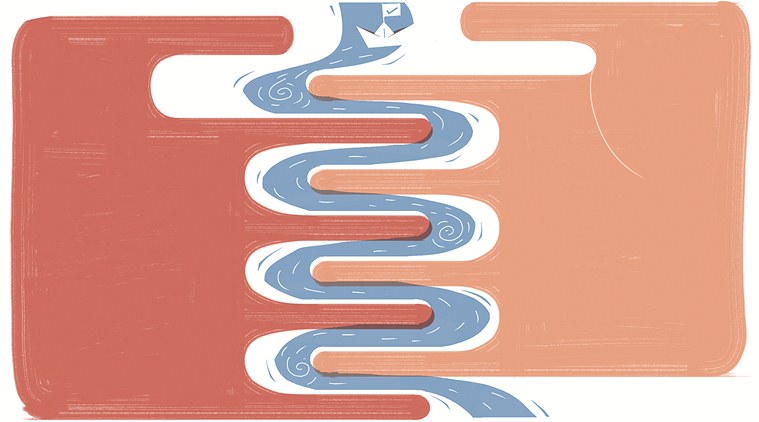River, state and Centre
Cauvery Authority’s challenge lies in forging federal consensus on Centre’s role in inter-state rivers. This could guide the making of a policy on river water sharing.

Responses to contingencies, such as complying with the Supreme Court’s orders on the Cauvery dispute, are unlikely to result in greater acceptance for the Centre’s role in governing inter-state rivers. (Illustration: CR Sasikumar)
On June 1, the Centre notified the constitution of the Cauvery Water Management Authority (CWMA) to implement the Supreme Court’s February 16 verdict on one of the country’s longest water disputes. The Authority’s powers and functions assume importance in view of the unresolved tension between the Centre and states over rights and access to river waters. Its success will hinge on addressing this challenge and will require a broader federal consensus on the Centre’s role in governing inter-state rivers.
The CWMA sticks to the template of the Cauvery Management Board (CMB), recommended by the Cauvery Water Disputes Tribunal (CWDT) in its 2007 award. It will be a two-tier body supported by a technical arm, the Cauvery Water Regulation Committee. The new agency is, however, an elaborate version of the CMB. Its powers and functions signal a bold move towards asserting the Centre’s role in matters related to the Cauvery’s waters. However, if the CWMA is to follow the template of an agency recommended more than 10 years ago, why did the Centre take so long to constitute it? It cited the possibility of political turmoil, given that Karnataka was going to the polls in May, as the major reason for the delay. But was that the only reason? The history of tribunal awards’ implementation points to something deeper: A defunct policy space combined with the absence of robust institutional models to get states to cooperate and comply with awards.
This is not the first time that the Supreme Court has prevailed on a government to put in place arrangements for implementing its decisions or those of tribunals. In the case of the Cauvery alone, the Court directed the constitution of a Cauvery River Authority, with the support of a Cauvery Monitoring Committee, to implement the CWDT’s interim orders in the 1990s. Then, in 2013, the Centre had to constitute a Cauvery Supervisory Committee, once again following the Supreme Court’s orders. The Committee proved ineffective when the dispute escalated three years later. We may recall the 2016 stalemate when the Karnataka assembly resolved against complying with the Supreme Court’s order to release waters to Tamil Nadu. The CWMA is, however, different. Unlike the earlier interim arrangements, it is meant to be a permanent body.
This history of failed experiments partly explains the Centre’s hesitation. The apex court’s February decision required the government to produce a scheme within six weeks. With contempt charges hanging over its head, the Centre proposed the CWMA, a much refined and elaborate version of the CMB. The new agency pushes its predecessor’s envelope on several fronts but is likely to face several challenges.
It is important to pay attention to the moment of the CWMA’s arrival. It was approved by the Supreme Court on May 18, when Karnataka was going through political changes. The state’s lawyers, while submitting to the Court that they did not have instructions from the government, objected to the CWMA’s provisions pertaining to the Centre’s control over the Cauvery’s waters. They argued that the provisions impinge on the rights of the states. Kerala had similar objections.
This resistance from the states brings into sharp focus the longstanding tension around the distribution of power over water between the Centre and the states. The country has not done well to coherently delineate the tenuous functional relationship between Entry 17 (basis for the premise that water is exclusively a state subject) and Entry 56 (regulation of inter-state river waters) of the Constitution’s Seventh Schedule. The CWMA’s powers and functions to implement the Supreme Court’s decision are loaded in favour of the Centre under Entry 56. The real challenge will lie in operationalising these powers. Even though the Supreme Court did not find merit in the objections of Karnataka and Kerala, they are bound to be raised again, after the CWMA becomes operational. The Authority’s response would be crucial, not just for the Cauvery water dispute but also for other inter-state water sharing arrangements.
All this needs an acknowledgment of the real problem in making inter-state river water sharing arrangements like the CWMA work. It is about getting states to accept a greater role for the Centre in governing inter-state river waters — as mandated under Entry 56. This requires a comprehensive policy response drawing on the force of a broader consensus between states about reworking their relationship with the Centre in managing inter-state rivers. In other words, the states have to agree to cede the necessary functional space to the Centre in the governance of inter-state river waters. This cannot happen without a nationwide debate and deliberations, similar to those that went into the making of the GST Council.
Responses to contingencies, such as complying with the Supreme Court’s orders on the Cauvery dispute, are unlikely to result in greater acceptance for the Centre’s role in governing inter-state rivers. Instead, a federal consensus has to be the basis for resuscitating the River Boards Act, 1956. The Act has remained in disuse since its inception. None of the existing river water boards were actually created under this act. The task of building the consensus should begin by trying to find the reasons for this anomaly. There should also be an audit of the successes and failures of the existing river water boards.
Such debates could feed into the CWMA’s work. How the agency fares could contribute to the larger unfinished agenda of formulating a comprehensive policy for inter-state river water cooperation.
The writer is a fellow with the Centre for Policy Research, New Delhi.
For all the latest Opinion News, download Indian Express App
More From Srinivas Chokkakula
- Parting the watersSupreme Court’s landmark Cauvery verdict points to new directions but will face tough challenge in lean rainfall years. ..
- A stronger river refereeThe Supreme Court, too, has been amenable to Special Leave Petitions which then lead to extended litigation in the apex court. All this defeats the…
- The Middle Ground On WaterPermanent Water Tribunal needs supplementary institutions..








































No hay comentarios:
Publicar un comentario